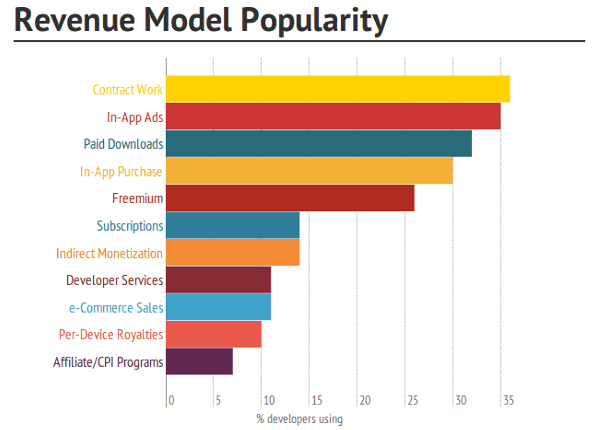To succeed in WebRTC, you need to look at what works in the app economy first.
I’ve been poring over the words written on Developer Economics lately. It is a part of Vision Mobile, a research outfit I highly value. In one of their latest articles, they made an analysis of the revenue models app developers go for. It is a very interesting article that you should read as well.
If you are looking for some tidbits from that article, then here they are:
- Contracting is the most popular revenue model and also the one associated with the second lowest probability of making a loss
- Paid downloads are the least successful revenue model
- Providing services that app developers can resell is one model for those selling developer services. Others include tools or services that help developers design, build, market or monetise their apps. This is one of the lower risk models with a good probability of profit
- Apps that make money through e-Commerce are the most successful in terms of making comfortable profits
Let’s try and translate it to WebRTC-speak:
- Contracting your developer skills to others who need WebRTC development done has a low probability of making a loss. I’d add that it is in high demand and low supply if you ask LinkedIn for WebRTC skills
- Building yet-another-video-calling-service and expecting to make money out of it has a high probability to fail. Too many of these “Hello World” services around
- Tools for developers are hugely popular. It is why I have a report on a niche of that specific domain… And as Developer Economics state in that article – the game isn’t over for new entrants either – assuming they have something interesting and useful to offer
- Making money from communication is hard. Making money from context (and business processes) is a lot easier
There are a lot of similarities between the WebRTC ecosystem and what is happening today in the mobile app economy. As the mobile app economy has a head start of a few years, we can deduce from the progress made there of how the future of WebRTC might unfold.


“Paid downloads are the least successful revenue model”
Yep, it is so much easier to get end users to use a product if there is nothing to pay. Payment is just a big barrier to entry.
People used to say that if only we had a micro payment system… I’m still not a 100% convinced. Although there is a really good Dogecoin tipping community.
I’m also always reminded by what Gabe Newell from Valve said (paraphrasing):
Free games sounds like a really bad idea. But free games get 10 times as many users and 3 times as much profit. The incremental cost of adding new users is very small.
In their case, free games are massively multiplayer online games (MMO) where people, can sell their hats and other things they’ve designed/created to others and Valve gets a small cut.
My main concern was around WebRTC and VoIP. Most solutions out there are too entrenched in voice minutes or subscription as the road to revenue, where the truth is it needs to come from elsewhere – because WebRTC removes all barriers.
Yes, totally right.
As I mentioned, remove as many barriers as possible. It is the best way to gain users.
Look at the Github business model. Deliver a free public service for people to collaborate as frictionless as possible on a large scale. And allow businesses to run their own behind the firewall or use private repositories on the public service.
I should add, I understand what you mean.
You might not need to remove more barriers, WebRTC already removes some of them. I’m just saying: removing more barriers might help gain you even more users.
There is also the concept of a usage-based freemium model, that both OnSIP and Twilio use. They offer a full featured, no-cost option for for the hobbiest or casual user, but charge per transactions for higher volumes.
Randy,
I see this as tools for developers. One of the options there is SaaS and in that domain, you can go for subscription and pay as you go options – but eventually it all boils down to selling stuff to other developers.